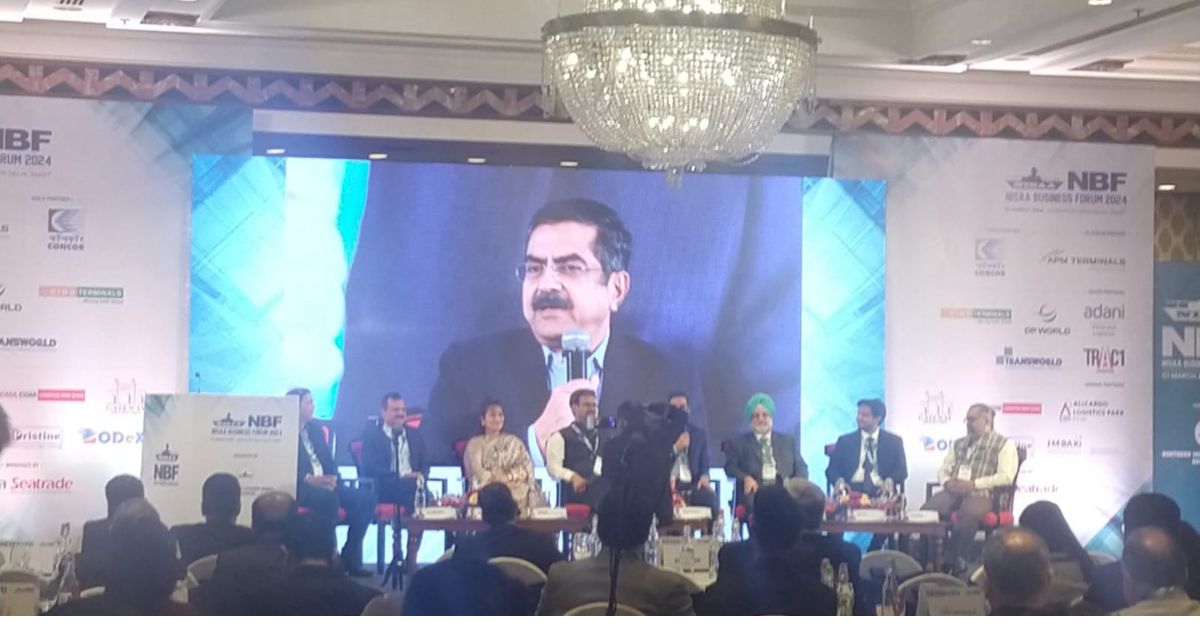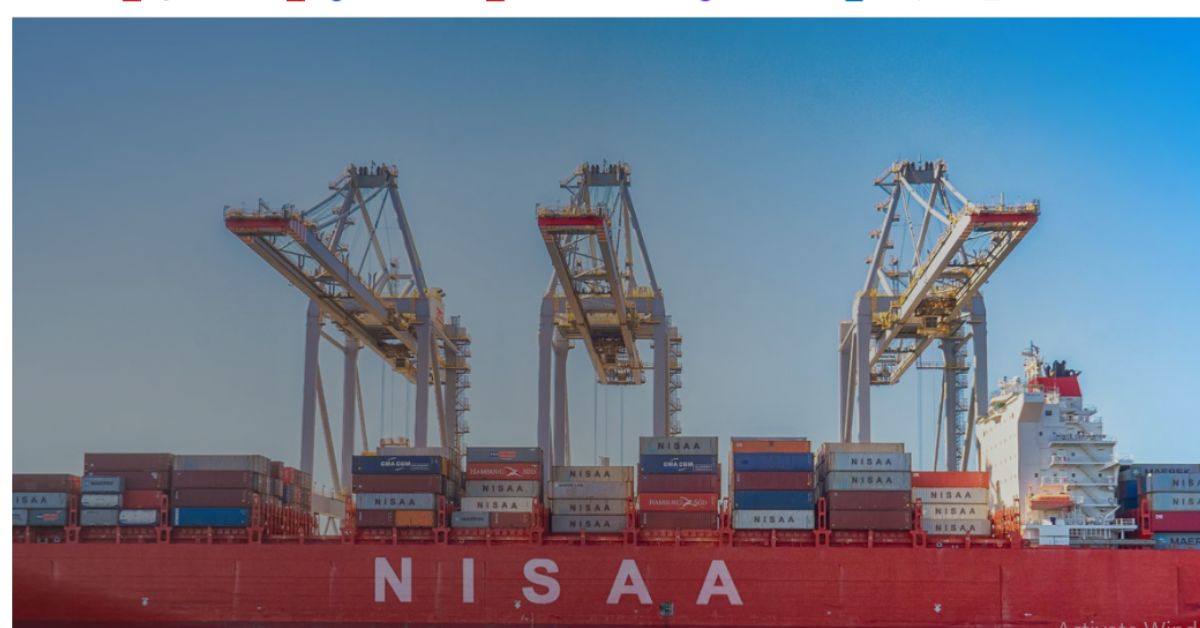
The annual NISAA Business Forum 2024, themed ‘Shipping & Logistics will witness a Sea Change by 2030: Is North India on course’, was held at the Sheraton Saket, this year. The assemblage of speakers covered a wide spectrum of the logistics industry. Capt. D. Mishra, President, Northern India Steamer Agents Association opened the conference by highlighting the all-round improvements in the logistics industry. According to the 2023 World Bank Logistics Performance Index (LPI) India, within five years, rose from a position of 44 in 2018 to 28, in the global rankings. By 2030, India was poised to come within the first 25 bracket.
The keynote address was presented by Sanjay Swarup. IRTS, Chairman & Managing Director, Container Corporation of India (CONCOR). Dwelling on the theme, Swarup was sanguine that North India was ready to take on the challenge of the vast improvements that were happening in the industry. He said that the World Bank had estimated the size of the Indian logistic market to be US$ 318 billion and it was likely to increase every year. It was the focus area of the Government also because the target given by the Prime Minister Narendra Modi, was that by 2047 India should be a developed nation. He said that the Government was committed to bringing down the logistics costs to single digit. CONCOR was already involved in extensive use of IT, by having APP based systems. He also emphasised on the importance of working toward sustainability in logistics. To give a fillip to green drive, he advocated the use of electric trucks for local transportation in terminals.
The first session of the conference was on the ‘vision of Mult-modalism in North India.’ The first speaker of the session was Abhishek Agarwal, Senior Specialist Director, NITI Aayog. He said that by 2047 India would be a developed nation. What did this entail? India would have the largest population in the world which would be roughly 20% of the global population. This population would be condensed in a space that would be less than 3% of the entire geographical area of the world. There would be, in India, a very dense situation of production, consumption and movement patterns. Further there would be about eight to nine times increase in per capita incomes, which meant that the consumption will go up drastically. This also implied manufacturing capacity would go up 10 times by 2047, and the international trade will increase 20 times. It was obvious that transportation was also going to grow exponentially. The overall logistics requirement will increase by four to five times by 2047.The railways requirement or demand will increase by six to seven times. The same would apply for marine pipelines, airports, all other modes of transport. road, Globally Containerisation was pegged at about 19%. India was much better off at 22%.
Agarwal had some startling facts on warehousing. He said that about 90% of warehousing was in the unorganised sector. Seventy five percent of the organised warehousing was under the government which meant that only 2.5% of the entire warehousing market in India was in the organised sector. About 80% of the typical warehousing size in India was less than 10,000 sq. ft. Whereas in the USA, more than 60% were bigger than 10,000 sq. ft. In Germany, more than 80% were bigger than 10,000 sq. ft.
Kamal Jain, Executive Director – (OPS, BD, Business Solutions) said that in all the states in northern India CONCOR had its own terminals except in Jammu & Kashmir. They expect to have one soon.
CONCOR was creating a hub and spoke for those terminals which were not connected with the DFC. Terminals in Moradabad, Ludhiana, Pantnagar, Kanpur were being connected to MMLPs like Kathuwas and Swaroopganj. From these multimodal terminals, double stack containers were sent to the gateway ports. Each double stack container could carry up to 180 containers. CONCOR was also now able to offer scheduled trains with assured transit times. Earlier the transit time Mundra was about 65 hours, has now been reduced to 36 hours.
Dr. Shefali G Singh, Additional Commissioner, Noida Customs Commissionerate dwelt on the progress made by the customs particularly regarding the ‘ease of doing businesses. One of the important areas that Customs were currently involved in, were the Prime Minister’s Gati Shakti initiative. Customs was the nodal agency for the formation of the new ICDs and CFSs and airfield stations across the country. The Customs Member was the chairperson of the inter-ministerial committee which was looking into the proposals for formation of new ICPs and CFSs. In the last two years, 16 new ICDs have been given approval and the target was to streamline the process of clearances as much as possible. All these were being done under the initiative of Gati Shakti.
Singh wanted the trade to be aware of the concept of Authorised Economic Operators programme (AEO).
It was a program that was initiated by the World Customs Organization (WCO) that sought to secure the supply chain globally and promote facilitation of trade. She invited the logistic operators to be a part of this programme. It sought to ensure that customs facilitation was increased to the highest level for all the partners in this initiative. The details were also available on their website, for enrolment and for processing.
The other benefit of this program was the Mutual Recognition Arrangement (MRA). In this programme the Indian Customs has signed with the customs of other countries whereby they mutually recognize the AEO operators of each other and give them a higher facilitation. With this arrangement the entire supply chain not only secured but also received supported from the customs of other countries. Presently the Indian customs has signed the MRA with five countries and they expect to sign with many more. With this facilitation, the entire supply chain would be more secure owing to support by the customs from other countries.
Another area in the “Ease of Doing Business,” was the establishment of the Single Window Interface for Trade (SWIFT). SWIFT was a single window interface for facilitation of trade. Here all the import declarations have been made automated and all the allied government agencies have been rolled into it and through the Risk Management System (RMS).
The facilitation has been up by 87% in imports till 2022 and it will increase even further. It was a single window wherein an import declaration was filed online and all the NOCs which were earlier required to be taken physically and separately, have now been coalesced into a single window
In another new development Singh said that they had launched a second version of the ICEGATE. It gave the trade a much more personalised experience and also made it more friendly. The customs were now available 24 x7 at almost all their facilities.
The other speakers were IVS Murlidhar, Founder & President, MVS Consultancy; Ashish Vaid, CEO AKJ India; Capt. Anil Sahni, Former President NISAA & Ex Vice President YML India, and Santosh Breed, CFO, APM Terminals Pipavav.
The second session focussed on ‘AI dominance will drive North India aspiration to become a significant logistic powerhouse’. Parvinder Singh, Managing Director, Hans Informatic Pvt Ltd, dwelt on how AI would help us in shipping. Singh sought to demystify the concept of AI and its applications. AI could work wherever big data was available. Data models were built on big data. The more data was available, the more accurate would be the AI. AI doesn’t work without human intelligence.
Dr.Surendra Kumar Ahirwar, Joint Secretary, DPIIT, Ministry of Commerce & Industry, said that India was currently witnessing a digital wave and it was manifest in many ways. There’s a digital public infrastructure initiative, which spanned across different departments. The government was leading by example, not just at the national level, but globally also. The government of India, along with the public sector, was leading this movement, called the digital revolution. In the last G 20 conference, the meeting, we gave to the world the Constitution for digitalization of trade processes and the ecosystem for logistics. The government of India had formulated ten principles, which were almost like ten commandments for the digitalization of the logistics sector. It was digitalization that they were trying to promote. The constitution, which India had developed, would be followed by the G 20 countries and he hoped that the rest of the world would also follow.
Kamna Vaid, Assistant Professor, Maharaja Agrasen Institute of Management Studies, said that since we were using technology, we were per se moving towards digitization. It was correct to say smart logistics, since logistics implementation was being done using artificial intelligence, cloud computing, deep learning, IoT, big data, neural networks etc. Smart logistics solutions would help the logistics industry with applications of the last mile delivery, improve transport efficiency, and better inventory management. It would be more customer centric and it would integrate various tools. Currently the industry was using ERP tools. There was a need to integrate ERP systems with artificial intelligence.
The other speakers present were Dr. Mahendra Birhade, COO, Rail & Inland Terminals, DP World. Anuj Yadav Chief Technology Officer, Patang, Atul Kumar Bansal, Group IT Head, Gateway Distriparks Limited, Biju Nambisan, Head- IT & Digital, CMA CGM Agencies (India)Pvt Ltd.







